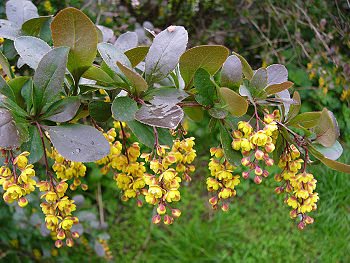Barberry
Other Names : Berberis vulgaris, Agracejo, Barberry, Berberidis Cortex, Berberidis Fructus, Berberidis Radicis Cortex, Berberidis Radix, Berbéris Commun, Berberis jacquinii, Berberis sanguinea, Berbéris Vulgaire, Berberis vulgaris, Berberitze, Berberry, Berbis, Common Barberry, Épine-Vinette, Espino Cambrón, Jaundice Berry, Mountain Grape, Oregon Grape, Pipperidge, Piprage, Sauerdorn, Sow Berry, Vinettier, European barberry
See also : Berberis vulgaris (Homeopathy)
The fruit, bark, and roots are used to make medicine.
Contents
Special Precautions of Barberry
- Avoid during pregnancy; barberry may stimulate the uterus.
- In high doses, barberry can cause nausea, vomiting, convulsions, hazardous drops in blood pressure, and depression of the heart rate and breathing. If you are suffering from heart disease or chronic respiratory system, do not take large doses of this herb and use only with the approval of your doctor.
- Use only in medicinal amounts. If the herb causes dizziness or faintness, stop using the herb immediately.
- Do not give to children under 2 years old. For older children and those older than 65, start with a lower strength than recommended above.
Active Compounds:
- Alkaloids of the isoquinoline type, mainly berberine, berbamine and derivatives, berberrubine, bervulcine, columbamine, isotetrandrine, jatrorrhizine, magnoflorine, oxycanthine and vulvracine
- Miscellaneous, including chelidonic acid, resin, tannin etc.
Actions
Diuretic, antibilious, refrigerant, stomachic, bitter tonic, antiperiodic, alterative, antipyretic
The benefits of Barberry are
Contains Berberine.
Barberry is closely related to Oregon Grape. Barberry, Oregon Grape, goldenseal and Coptis all contain isoquinolone alkaloids. Berberine is the most prominent of these alkaloids and according to laboratory studies, it has an antimicrobial, anti-inflammatory, hypotensive, sedative, and anticonvulsant effect. It’s possibly an immune system stimulant and helps with digestion and gastrointestinal pain. Berberine is found in the stem bark and rhizome of the plant. Berbamine is another alkaloid found in barberry and is thought to fight infections by stimulating the action of white blood cells.
- This medicinal herb has been used for more than 2500 years in Asia and the Mediterranean. In ancient Egypt barberry was used as a preventative against plague. The Ayurveda healers of India used barberry as a remedy for dysentery.
- Barberry has traditionally been used as a treatment for digestive disorders, skin irritations and lesions. It has anti inflammatory and antibiotic properties and has been used in the treatment of urinary tract and bladder infections, upper respiratory infections and abnormal uterine bleeding.
- Barberry may be beneficial to the cardiovascular and neural systems and may be used as a treatment for epilepsy and convulsions. It has also been used as an alternative treatment for tachycardia and hypertension.
- Barberry extract used in a salve may alleviate symptoms of psoriasis, but there is currently not enough clinical evidence to support this claim.
- It is commonly used to treat bacterial diarrhea and parasitic infections of the intestines. It is also used to treat fungal infections such as candida (yeast). *Additionally barberry may aid in digestion and prevent some symptoms of indigestion such as heartburn and nausea.
- Like its cousin oregon grape, barberry is thought to stimulate blood flow to the liver and improve liver function. It is also believed to stimulate the secretion of bile.
